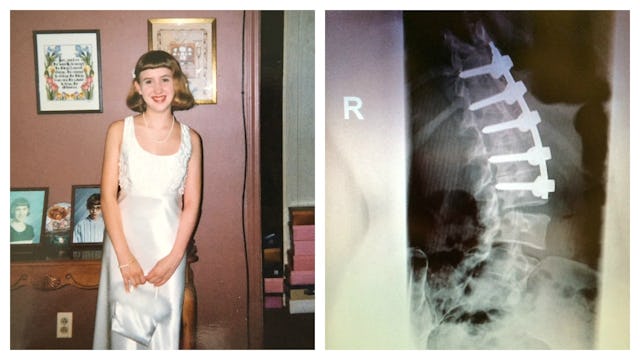This Is The Reality Of Living With Scoliosis

It’s funny how a single day can change your life — how a single moment can alter everything — and while I have had several such moments over the last 33 years, perhaps the most defining was the day I received “the diagnosis.”
My scoliosis diagnosis.
Of course, you may be wondering why. Scoliosis is fairly common, especially for young boys and preteen girls. In fact, according to the American Association of Neurological Services, it is estimated that scoliosis affects 3% of the population, and most cases are treatable and/or benign. Most spinal curvatures fix themselves over time.
However, my curvature wasn’t like other curvatures. I didn’t have a small curve or an unobtrusive “growing pains” sort of curve, I had multiple curves, including one large bend in my lower back.
One massive, 60-degree lumbar curve which could only be corrected one of two ways: I would have to wear a back brace and/or I would require surgery.
Both options seemed horrifying because they were. The mention of surgery is terrifying, at best, and a back brace? That was disconcerting too. However, since the operation was seen as a “last resort,” my mother and I chose the obvious route, and my body was casted, molded and then covered with a hard plastic case that ran from my underarms to my breasts, down my chest and over my abdominal cavity.
But that wasn’t the “best” part. The icing on the cake were the three huge Velcro straps I had to use to get said brace off and on and to tighten it, so the device could do its job and put pressure on my body, constricting any motion or muscles which might cause the curves to grow.
It was painful. Literally.
Not only was it painful, uncomfortable, and obtrusive, I didn’t get better. Instead, things got worse. Eventually my curve progressed to 70-plus degrees, at which point my doctor recommended I undergo an 8-hour operation to support and fuse my spine.
And I did. When I was just 15-years-old, they cut me open, ground me down, and inserted five screws and one long metal rod into my back. Unlike the brace, this treatment was effective.
But despite the fact that my scoliosis had been treated — despite the fact that my surgery was a “success” and the issue was“resolved” — I am still impacted by my scoliosis. Eighteen years later, I still live with the pain caused by my surgery and I always will.
It is a chronic condition. It won’t go away.
Of course, there are the obvious residual effects of my deformity. I get a lot of localized pain and swelling. And while some days I am fine, other days walking hurts. Sitting hurts. Standing hurts. Everything hurts.
Some days, I literally cannot get out of bed.
Because of my scoliosis, and spinal fusion surgery, I cannot do sit-ups. I cannot do flips, backbends, headstands or handstands (though, if I’m being honest, I couldn’t do them before my diagnosis either). And while this may sound strange, sometimes my scoliosis actually causes me to fall. Because one of my legs is shorter than the other, I trip on my own feet.
But the worst part about having scoliosis isn’t the physical pain, it is the emotional pain. It is the mental and psychological effects of growing up with a visible deformity. And while in my case said condition was only “visible” for two years, during those two years, I was mocked, taunted, teased, and harassed. I was bullied, during my most formative years, because of something entirely outside of my control. It was brutal.
The emotional scars from their jests, like the 16” surgical scar along my left ribcage, remain.
I still struggle with feeling not “good enough” or “pretty enough.” I still walk around every day trying my best to blend in. I am incredibly self-conscious. I often avoid eye contact. I try not to — it is something I work on everyday — but that is the reality of my life with scoliosis.
That said, scoliosis isn’t all bad. Regardless of the state of your life or the size of your curve, scoliosis isn’t a damning or terminal condition. It can be rehabbed and cared for. It won’t be easy, but you (and your scoliosis) can be treated, and while life with scoliosis can be painful and hard, it can also be a gift.
My scoliosis was a blessing in disguise.
How? Well, because of my condition, and how badly it used to limit me, I am a very active adult. I lift weights and do yoga. I cycle, I hike, and I run. I run 5ks, 10ks, and half marathons for fun because running reminds me I can do anything. It reminds me I am not broken or weak. I am not a porcelain doll, and it gives me a sense of strength I never imagined possible.
On the asphalt, I found power, courage, and confidence.
Make no mistake: it is still hard. Physically, mentally, and emotionally “life with scoliosis” is still hard. But I keep going. In spite of the pain, I keep moving forward, because I am more than these physical and emotional scars that have been put upon me.
I am more than my diagnosis. You are too.
This article was originally published on